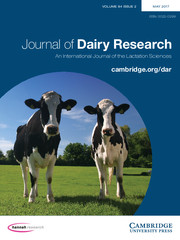Ver ítem
- xmlui.general.dspace_homeCentros Regionales y EEAsCentro Regional Santa FeEEA RafaelaArtículos científicosxmlui.ArtifactBrowser.ItemViewer.trail
- Inicio
- Centros Regionales y EEAs
- Centro Regional Santa Fe
- EEA Rafaela
- Artículos científicos
- Ver ítem
Use of cheese whey for biomass production and spray drying of probiotic lactobacilli
Resumen
The double use of cheese whey (culture medium and thermoprotectant for spray drying of lactobacilli) was explored in this study for adding value to this wastewater. In-house formulated broth (similar to MRS) and dairy media (cheese and ricotta whey and whey permeate) were assessed for their capacity to produce biomass of Lactobacillus paracasei JP1, Lb. rhamnosus 64 and Lb. gasseri 37. Simultaneously, spray drying of cheese whey-starch solution (without
[ver mas...]
The double use of cheese whey (culture medium and thermoprotectant for spray drying of lactobacilli) was explored in this study for adding value to this wastewater. In-house formulated broth (similar to MRS) and dairy media (cheese and ricotta whey and whey permeate) were assessed for their capacity to produce biomass of Lactobacillus paracasei JP1, Lb. rhamnosus 64 and Lb. gasseri 37. Simultaneously, spray drying of cheese whey-starch solution (without lactobacilli cells) was optimised using surface response methodology. Cell suspensions of the lactobacilli, produced in in house-formulated broth, were spray-dried in cheese whey-starch solution and viability monitored throughout the storage of powders for 2 months. Lb. rhamnosus 64 was able to grow satisfactorily in at least two of the in-house formulated culture media and in the dairy media assessed. It also performed well in spray drying. The performance of the other strains was less satisfactory. The growth capacity, the resistance to spray drying in cheese whey-starch solution and the negligible lost in viability during the storage (2 months), makes Lb. rhamnosus 64 a promising candidate for further technological studies for developing a probiotic dehydrated culture for foods, utilising wastewaters of the dairy industry (as growth substrate and protectant) and spray drying (a low-cost widely-available technology).
[Cerrar]

Autor
Lavari, Luisina;
Paez, Roxana Beatriz;
Cuatrin, Alejandra;
Reinheimer, Jorge Alberto;
Vinderola, Celso Gabriel;
Fuente
Journal of Dairy Research 81 (3) : 267-274 (August 2014)
Fecha
2014-08
ISSN
0022-0299
1469-7629
1469-7629
Formato
pdf
Tipo de documento
artículo
Palabras Claves
Derechos de acceso
Restringido
 Excepto donde se diga explicitamente, este item se publica bajo la siguiente descripción: Creative Commons Attribution-NonCommercial-ShareAlike 2.5 Unported (CC BY-NC-SA 2.5)
Excepto donde se diga explicitamente, este item se publica bajo la siguiente descripción: Creative Commons Attribution-NonCommercial-ShareAlike 2.5 Unported (CC BY-NC-SA 2.5)

